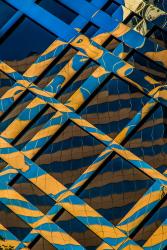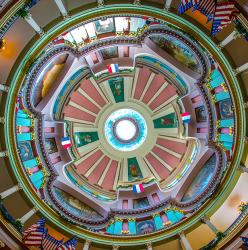Patterns are found everywhere in design but when they are found in architecture the beauty of the repeated elements, curves and angles can become abstract in form. A winding staircase, beautiful domed ceiling or the repeated windows in a high-rise building, all can be inspiration for abstract patterns. Taking that risk to create something unique and different is trending in architecture with organic, oddly shaped forms and futuristic concepts. Many photographers gravitate to architectural photography to capture these patterns in action by using bold geometric compositions, and abstract aesthetics that many find hypnotic. By focusing on sculptural patterns and repetitions, abstraction is created. Local St. Louis photographer Larry Emerson has a keen eye for color and pattern. Larry’s photographs depict these concepts of abstract patterns within architecture. Sometimes, taking the time to look deeper allows us to see the world around us a little But what truly is abstract? Abstract is a word used to describe the art form that uses visual language of shape, form, color and line to create a composition. In fine art, it is a broad movement in American painting that began in the late 1940s and became a dominant trend in Western painting during the 1950s. The most prominent American Abstract Expressionist painters were Jackson Pollock, Willem de Kooning, Franz Kline and Mark Rothko. The artwork they created depicted forms not found in the natural world. The painters of this time who were exploring Abstract Expressionism set the path for a new way of thinking about art and design. Architecture and interiors began evolving from a standard way of rectilinear high-rise design to creating buildings or interiors that were more of an art form. The Guggenheim Museum in New York is a wonderful example of this evolution to unique, abstract thinking in architecture. A concrete, spiral form among the historic and straight-lined buildings of the downtown area is a direct contradiction to its surroundings. With the evolution of new materials and building trends, architecture abstraction will follow. 3D-printed structures, extraterrestrial-like megastructures and futuristic cyborg shapes may all be in our near future for the evolution of buildings in architecture. So, take the time, and look deeper at the world and see that patterns are everywhere around us.
Design 101
Abstract Patterns in Architecture
By Wendy Noory
Photography by Larry Emerson







